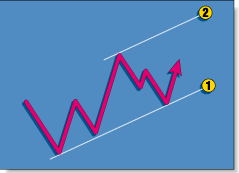As computers and technical analysis software become more and more sophisticated, there is an increasing reliance by traders on using indicators for trading signals. This focus on using technical indicators for developing trading systems is a reasonable step, but along the way, a certain craft, using simple price charts to gauge what a market is doing, has been lost.
CLASSIC TECHNIQUES
Channel Analysis
by Thom Hartle
A market does not move in a straight line; instead, its movement travels across the chart in peaks and valleys, forming a channel in the direction of the trend. Early identification of the channels can give you important information, including that the trend has changed direction, what the profit objectives are and risk points.
But why the movement away from chart analysis? Once more, the answer centers around simplicity; traders have found that, much to their delight, indicators are easy to program, modify and design trading systems around. There is an additional appeal, because most indicators can smooth the price action and have specified range limits such as zero to 100. This feature gives the trader the sense that noise has been filtered from the markets. The apparent moment-to-moment randomness in a market is due to the market participants therein acting in the marketplace for their own diverse reasons. The result? The underlying price trends are clouded by the impact of these traders. As a result, traders have grown dependent upon indicators that filter the price action and produce reliable trading signals.
For example, consider an open-high-low-close bar chart for the Treasury bond contract. The intraday fluctuations are important, but often the highs and lows represent momentary extremes, whereas the closing price represents the mark-to-market accounting for portfolios and is really the bottom line for the day's activity.
Most daily technical indicators also use the closing price for calculations. In fact, try using your favorite indicators plotted in one window with just the closing price plotted above, such as the closing price for the March Treasury bond contract with a 14-period relative strength index (RSI). The normalization step in the RSI calculation creates a range of values between zero and 100, effectively compressing the values, but you can see how close the RSI mimics the closing price. Any indicator that uses the closing price is a filter of the daily bar activity, because the indicator ignores the intraday noise about the trend of the closing prices. The closing price is an important tool, so I use the closing price as the basis for my chart analysis.

FIGURE 1: UPWARD CHANNEL, RESISTANCE. Identify two low closing prices and draw line 1. Use the extreme high closing price between the two low closes to draw your parallel line.
My trendlines are a line of sight from two points along the river's bank, and as long as that line of sight is not broken, the river's direction is parallel to that line of sight.